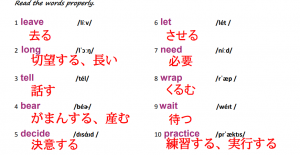
英語でプレゼンテーションを行っていると、気になってくるのがプレゼンテーションの成功率では
ないでしょうか?
プレゼンテーションで何より大切なのは準備です。
「100の準備をして99を捨てる覚悟で臨む」と成功する、と言われますが英語でのプレゼンテーションとなるとそうは簡単にいきません。
英語でのプレゼンテーションの成功率をあげるためにも、知っておきたいコツをご紹介します。
最初と最後を締める!

英語でのプレゼンテーションで知っておきたい1つ目のコツには「最初と最後を締める」ことです。
最初で場の空気を締めることが出来ずスベってしまい、プレゼンテーション中に勢いや雰囲気を
回復出来なかったという経験は多くの方があると思います。
そのためにも一言目の英語の発音がとても重要です。
Ladies and Gentlemen!
皆が知っているこのセリフも発音に工夫を凝らすと、聴衆の注目を集める言葉になります。
棒読みせず、音を強調して発音するようにしましょう。
子音を強調するコツは、 L、d、s、(z)、g、t、を発音する際に腹式呼吸を使うことです。
お腹で思いっきり息を吸って、吐きながら発音するようにしましょう。
また母音を発音する時は、体全体に響かせるようにしましょう。
そうすることで深みのある音を作れます。
最後の”Thank you for listening!”は心を込めて伝えましょう。
特にTh、k、f、l、sn、の子音とth、fの部分で息を吐いて、勢いをつけることがポイントです。
最初と最後を自分のペースに持ち込めれば、気持ちの面でも余裕が生まれプレゼンテーションに
説得力を与えることができます。
プレゼンテーションは「明確さ」が大切!

英語のプレゼンテーションでは目的をハッキリと告げることが欠かせません。
欧米の思考では「なぜ、なんのために?」という問いを常に持ちます。
その問いに答えないままプレゼンテーションを進めてしまうと、聴衆の苛立ちを生む
恐れがあります。
また、時間の告知もする必要があります。
終わりの時間を最初に伝えておくことは重要なテクニックです。
「いつまでこの話が続くの?」と感じた時点で、聴衆の集中力は切れてしまいます。
その疑問を持たせないため、プレゼンテーションがまとまっている印象を与えられるためキチンと
伝えるようにしましょう。
さらに話の概略は3つに分けるのが一般的です。
3つ以上だと聴衆の集中力が削がれるので、概略を把握できる3つがオススメです。
プレゼンテーション時は自信を持つ!

英語のプレゼンテーション中は自信を持って話しましょう。
聴衆は話している姿によって、プレゼンテーションの印象が左右される部分があります。
プレゼンテーション中に自信を持つためには、ビジネス英会話の能力を伸ばすことが欠かせません。
たとえ上手く発音できていないと感じても、自分で自信を持てるほど勉強をすれば自然と不安は
消えていくでしょう。
プレゼンテーション前に集中してビジネス英会話に取り組むのではなく、日ごろからビジネス英会話に触れておくことで、十分なプレゼンテーションの準備になり慌てず落ち着いて取り組めるのでは
ないでしょうか。



























